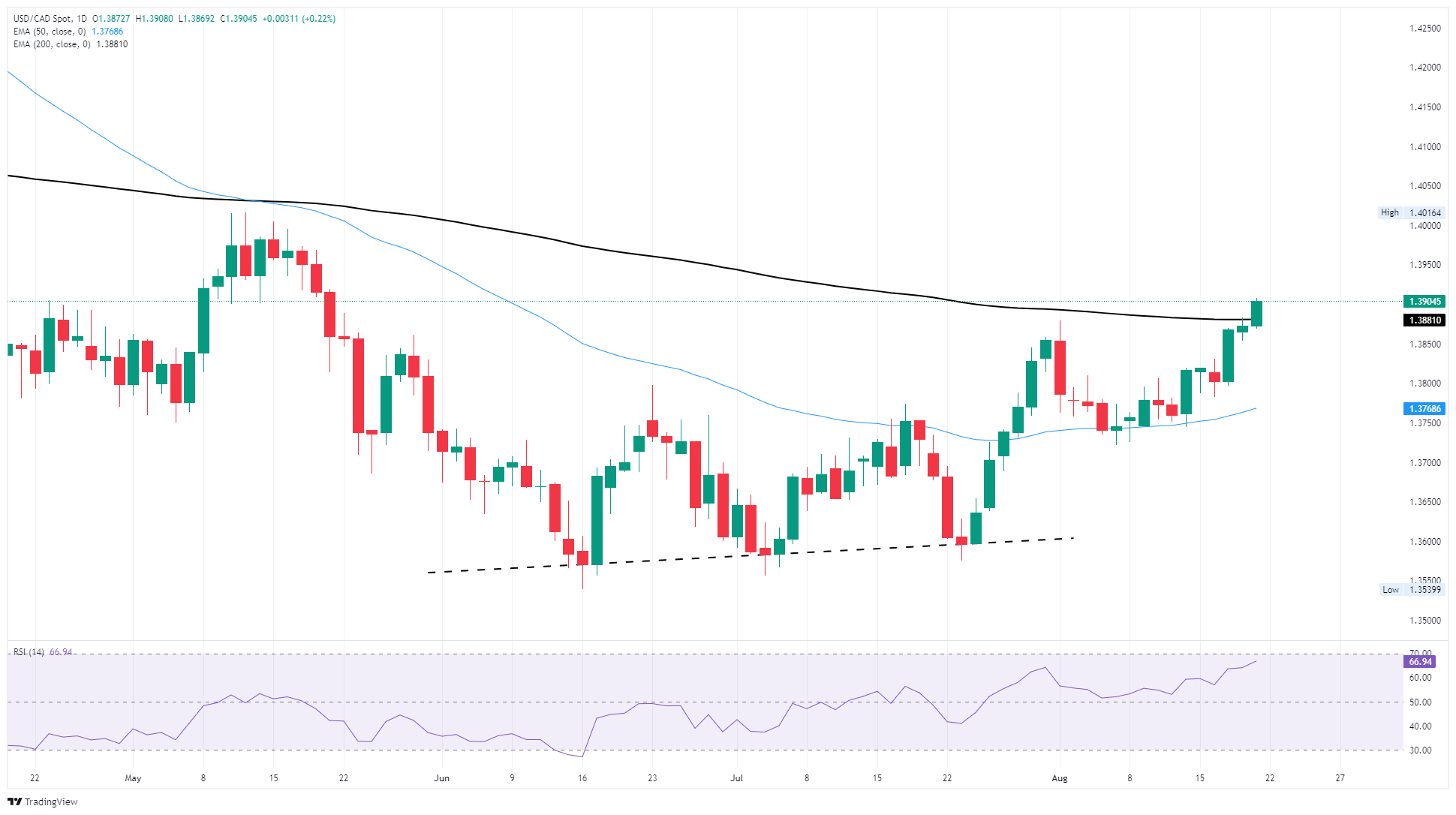Canadian Dollar weakens again amid fresh Greenback bids
- The Canadian Dollar pared back further against the US Dollar on Thursday.
- The Loonie is facing fresh 13-week lows against the Greenback.
- A lack of Canadian data is keeping the US Dollar in the driver’s seat.
The Canadian Dollar (CAD) took another step down against the US Dollar (USD) on Thursday, dipping into fresh 13-week lows and pushing the USD/CAD pair back into the 1.3900 handle. The Canadian Dollar is steadily declining in a one-sided technical slide as Loonie traders await reasons to shift their stance.
Central banking is taking a front seat for the remainder of the week, specifically the Federal Reserve (Fed) and the likelihood of Fed policymakers delivering a much-anticipated interest rate cut in September. The Fed Bank of Kansas has kicked off its annual economic symposium in Jackson Hole, but markets will be looking ahead of Fed Chair Jerome Powell’s appearance at the policy shindig on Friday.
Daily digest market movers: Canadian Dollar continues to give up ground to the US Dollar
- The Canadian Dollar fell another one-quarter of one percent against the US Dollar on Thursday.
- The CAD has lost ground to the Greenback for three straight sessions in a one-sided bearish push.
- Mixed US PMI figures kicked the US Dollar higher on Thursday, as businesses continue to pass tariff impacts onto consumers amid rising inventory stockpiling.
- Fed officials have been pivoting back into more hawkish language on interest rates after a recent uptick in US inflation data.
- Markets are still hoping for a quarter-point rate cut on September 17, but rate cut bets are facing fresh challenges in the weeks ahead.
Canadian Dollar price forecast
Fresh weakness keeping the Canadian Dollar pinned on the low side is bolstering the US Dollar, pushing USD/CAD into three-month highs. The pair has pushed into the 200-day Exponential Moving Average (EMA) near 1.3880, putting Dollar-Loonie on pace for a fresh bullish extension. If Loonie bulls find their buy buttons again, the pair could quickly reverse course and snap back down to the 50-day EMA near 1.3770.
USD/CAD daily chart

Canadian Dollar FAQs
The key factors driving the Canadian Dollar (CAD) are the level of interest rates set by the Bank of Canada (BoC), the price of Oil, Canada’s largest export, the health of its economy, inflation and the Trade Balance, which is the difference between the value of Canada’s exports versus its imports. Other factors include market sentiment – whether investors are taking on more risky assets (risk-on) or seeking safe-havens (risk-off) – with risk-on being CAD-positive. As its largest trading partner, the health of the US economy is also a key factor influencing the Canadian Dollar.
The Bank of Canada (BoC) has a significant influence on the Canadian Dollar by setting the level of interest rates that banks can lend to one another. This influences the level of interest rates for everyone. The main goal of the BoC is to maintain inflation at 1-3% by adjusting interest rates up or down. Relatively higher interest rates tend to be positive for the CAD. The Bank of Canada can also use quantitative easing and tightening to influence credit conditions, with the former CAD-negative and the latter CAD-positive.
The price of Oil is a key factor impacting the value of the Canadian Dollar. Petroleum is Canada’s biggest export, so Oil price tends to have an immediate impact on the CAD value. Generally, if Oil price rises CAD also goes up, as aggregate demand for the currency increases. The opposite is the case if the price of Oil falls. Higher Oil prices also tend to result in a greater likelihood of a positive Trade Balance, which is also supportive of the CAD.
While inflation had always traditionally been thought of as a negative factor for a currency since it lowers the value of money, the opposite has actually been the case in modern times with the relaxation of cross-border capital controls. Higher inflation tends to lead central banks to put up interest rates which attracts more capital inflows from global investors seeking a lucrative place to keep their money. This increases demand for the local currency, which in Canada’s case is the Canadian Dollar.
Macroeconomic data releases gauge the health of the economy and can have an impact on the Canadian Dollar. Indicators such as GDP, Manufacturing and Services PMIs, employment, and consumer sentiment surveys can all influence the direction of the CAD. A strong economy is good for the Canadian Dollar. Not only does it attract more foreign investment but it may encourage the Bank of Canada to put up interest rates, leading to a stronger currency. If economic data is weak, however, the CAD is likely to fall.

